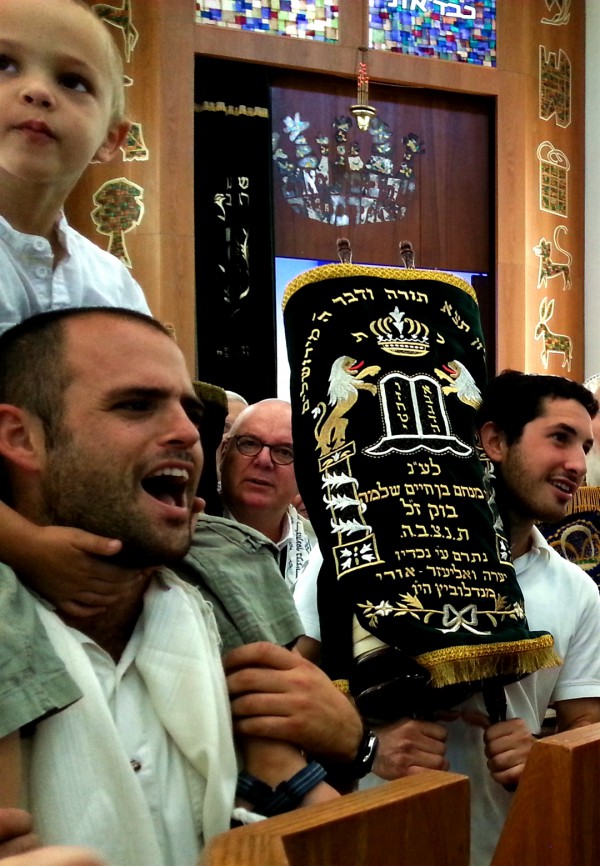Terumah (Offering)
Exodus 25:1–27:19; 1 Kings 5:26 (12)–6:13; 2 Corinthians 9:1–15
“Then have them make a Sanctuary [Mikdash] for Me, and I will dwell [ve-shakhan-ti] among them. Make this Tabernacle [Mishkan] and all its furnishings exactly like the pattern I will show you.” (Exodus 25:8–9)
In last week’s Parasha, Israel received God’s laws (mishpatim) at Mount Sinai after being delivered from bondage in Egypt.
In this week’s Torah portion, God calls on the Israelites to offer 13 materials for the construction of the Tabernacle (Mishkan) and its furnishings: gold, silver, and bronze (copper); blue, purple and scarlet yarn and fine linen; goat hair; ram’s skins; acacia wood; olive oil; spices; incense; and onyx and other gem stones. (Exodus 25:2–7)
The Tabernacle, where God dwelt among the Israelites, would be portable so that it, along with the Divine Presence, could move from place to place during the Israelites’ wilderness wanderings.
In fact, the Hebrew words for Mishkan (Tabernacle) and Shekinah (Divine Presence) are derivatives of the same Hebrew root word shakan, which means settle, inhabit or dwell.

These gold and silver vessels have been created by the Temple Institute in anticipation of the building of the Third Temple. The tall jug contains enough menorah oil for all seven lamps. That oil is poured into the smaller gold jug (bottom left), which replenishes the individual lamps. The bowl with the tongs and brush is for cleaning the Menorah.
Building the Sanctuary with a Freewill Offering
The title of this week’s Parasha comes from the 12th word in the Parasha, terumah, which means offering or contribution.
Immediately after the people declare their acceptance of the Torah at Mount Sinai, God asks them to voluntarily give their possessions toward the building of the Sanctuary. These voluntary acts of giving raise materialism to a level of holiness.
Before the Mishkan can be built, the materials must be gathered. There is no convenient building supply store where they can be easily purchased.
Still, the Israelites have everything that is needed to build it. Although they had been slaves in Egypt, they left with many precious things:
“The Israelites did as Moses instructed and asked the Egyptians for articles of silver and gold and for clothing. The Lord had made the Egyptians favorably disposed toward the people, and they gave them what they asked for; so they plundered the Egyptians.” (Exodus 12:35–36)
What did they first do with that wealth? They built a golden calf. That, of course, was the wrong way to use the treasure that God had given to them.
In this Parasha, they are called upon to use it the right way.
The wealth of Egypt, a nation that had worshiped false gods, was now to be used to build the Sanctuary of the One True God, the God of Israel.
Still, God does not demand the people turn over their precious metals, fabrics, or stones. He asks the people for a freewill offering—to give what is in their hearts to give. God did not set a minimum or a maximum amount.

Copper vessels for the Third Temple: On the left is the Abuv, a three-tiered stand used for roasting the Omer on Passover. The middle tier contains coal for roasting the barley. On the far right toward the back is the copper vessel used in preparing the meal offering.
“Tell the Israelites to bring Me an offering [terumah]. You are to receive the offering for Me from everyone whose heart prompts them to give.” (Exodus 25:2)
Love, Righteousness, and Justice
In Hebrew, the word terumah (offering) appears three times in the first two verses (pesukim) of this Torah portion.
According to Joe Bobker in Torah with a Twist of Humor, this perhaps indicates that there are three types of givers who are motivated by one of the following three levels of giving:
- The highest level of giving is done because God says to do it.
- A level down from this is giving for selfish reasons—to feel good by giving to someone in need or to a worthy cause or, perhaps, to receive acknowledgment and accolades.
- The lowest level is giving motivated by shame or guilt.

Charity is such a fundamental part of the Jewish way of life, that traditional Jewish homes usually have a special box for collecting money for the poor. That box is called a pushke.
In the Brit Chadashah (New Testament), Paul’s request that people provide for the needs of other Believers echoes God’s request that the people provide a freewill offering for the building of the Mishkan.
In each instance, the gifts were to reflect what was in the giver’s heart to give.
“Each of you should give what you have decided in your heart to give, not reluctantly or under compulsion, for God loves a cheerful giver. And God is able to bless you abundantly, so that in all things at all times, having all that you need, you will abound in every good work.” (2 Corinthians 9:7–8)
While the word charity today indicates benevolence toward the needy, the Latin root of the word means affection or love.
The corresponding Hebrew word for charity is tzedakah, meaning righteousness or justice.
The giving of tzedakah in the Hebraic sense, therefore, represents the building of a righteous and just society.
Love, righteousness, and justice are interwoven.
In fact, the Brit Chadashah (New Testament) states that if we do not provide materially to a brother in need, the love of God cannot be residing in us.
“But whoever has the world’s goods, and sees his brother in need and closes his heart against him, how does the love of God abide in him?” (1 John 3:17)
Yeshua said that there is a greater blessing in giving than in receiving (Acts 20:35).
Still, it is not just the act of giving that matters, but the motivation behind it; that motivation must be love.
Indeed 1 Corinthians 13:3 states, “If I give all I possess to the poor and give over my body to hardship that I may boast, but do not have love, I gain nothing.”
Avos d’Rabbi Nosson, a classic Jewish commentary, echoes this when it says, “If one gives his fellow all the good things in the world but with a sullen face, it is as if he has given nothing.”
The offering to build God’s house cannot be given with a sullen face. It is intended to be an act of worship that elevates us spiritually.
The root of terumah, R-U-M, means exalted, uplifted, fortified or encouraged.
An offering to build God’s first Sanctuary was to be given with a pure attitude of worship, so God made it a freewill offering.
Still, even though it was a freewill act of worship, the children of Israel could not build a Sanctuary for God any old way they wanted.
They had to build it according to a specific pattern, the pattern that was shown Moses on the mountain. (Exodus 25:9)
Why an Earthly Sanctuary
Why does a non-earthly, omnipresent God require a specific, physical earthly space to dwell in?
Even God Himself said, “Heaven is My Throne, and the earth is My footstool. Where could you build a house for Me? What place could possibly serve as My abode?” (Isaiah 66:1)
In this week’s Haftarah (Prophetic portion), King Solomon, the wisest man on earth, builds the First Temple, using the plans and resources given to him by David.
It is to be a permanent place for the Shekinah or Divine Presence to reside, and it is located in Jerusalem.
When Solomon dedicates that Temple, he underscores that God is so vast that heaven and earth cannot contain Him.
“But will God really dwell on earth? The heavens, even the highest heaven, cannot contain You. How much less this Temple I have built!” (1 Kings 8:27)
It is both humbling and inspiring to realize that God’s Shekinah (Divine Presence) would rest in a structure made by human hands. Even prayers made toward this Temple would move the heart of God.
“May your eyes be open toward this Temple night and day, this place of which You said, ‘My Name shall be there,’ so that You will hear the prayer Your servant prays toward this place. Hear the supplication of Your servant and of Your people Israel when they pray toward this place. Hear from heaven, Your dwelling place, and when You hear, forgive.” (1 Kings 8:29–30)

In accordance with King Solomon’s prayer, an Ethiopian Jewish woman prays toward the Temple Mount where the First and Second Temples once stood.
So why does God want the Israelites to put forth all the time, expense, and effort to construct an elaborate sanctuary as His abode?
One reason is that building it is an act of teshuvah (repentance) for making the Golden Calf.
The Israelites panicked when they thought Moses was not going to come down from Mount Sinai.
After coming out of Egypt where every god was put on display, the Israelites craved some tangible reminder of who they were following and worshiping.

A Jewish man prays wearing tefillin (phylacteries) at the Western (Wailing) Wall. Many believe that God’s presence still remains here.
Fearful that they had lost Moses, whom they had chosen as their intermediary because the manifest glory of God terrified them, they told his brother Aaron, “Come, make us gods who will go before us.” (Exodus 32:1)
So, they made the Golden Calf and worshiped it.
According to traditional Jewish thinking, God contracted or contained (mitzamtzem) His Presence because the Israelites were not yet ready to live in God’s revealed presence.
God made for them an earthly representation of His heavenly dwelling—a pattern of the most holy place in Heaven where God sits on His throne.
In a way, the Mishkan filled a void or emptiness in the people, and God called His people to partake in filling that void, causing the Israelites to become His active partners in bringing holiness to the world.
The Mishkan (Tabernacle) served a temporary purpose where the people could follow and worship God; however, like much of God’s work on earth, it also served as a pattern of a Heavenly reality that will one day be revealed in its fullness:
“After this I looked, and I saw in Heaven the Temple—that is, the Tabernacle of the covenant law—and it was opened.” (Revelation 15:5)
When Yeshua (Jesus) who is Immanuel (God with us) returns—and that time is not too far away—the world will never be the same.
In the New Jerusalem, we will see and worship God in His fullness and He will dwell with us forever.
And I heard a loud voice from the throne saying, “Look! God’s dwelling place is now among the people, and He will dwell (shokhen) with them. They will be His people, and God himself will be with them and be their God.
He will wipe every tear from their eyes. There will be no more death or mourning or crying or pain, for the old order of things has passed away.” (Revelation 21:3–4)













